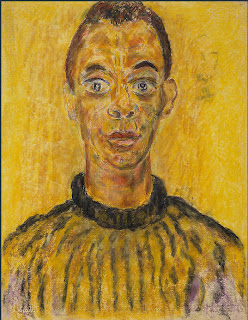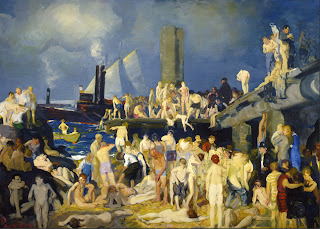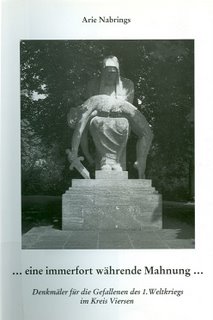
Portrait of Frank O'Hara
by Alice Neel (1960)
HIDE/SEEK
Difference and Desire in American Portraiture is an exhibit
currently running
at the National Portrait Gallery
and since that institution
ultimately reports
to a Congressional Committee
it is more sensitive
to political pressure
than privately owned museums.
Which has led to the controversy
so thoroughly covered by
The Washington Post On
November 30the director of the Smithsonian
G. Wayne Cloughremoved
a
David Wojnarowicz videothat included a brief scene of ants
crawling over a crucifix
after the
Catholic League asserted that it was
"designed to insult and inflict injury and assault the sensibilities of Christians"
While a
defender of the piece asserts
"the artist's own hopes that the passage would speak to the suffering of his dead friend"
and
"it is smack in the middle of the great tradition of using images of
Christ to speak about the suffering of all mankind -- a long, respectable history of showing hideously grisly images of Jesus"
 Romaine Brooks
Romaine Brooks self portrait, 1923
While judging from the short segment
linked above,
the video is a mangled cry of
despair, disgust, and anger
that's not worth any speculation at all.
But I think that all sides will agree
that the interpretion of the piece
is far less important
than the principle
of whether anyone
besides the curator
can have anything removed from the wall
of a national art museum.
As Philip Kennicott, cultural critic
of the Washington post,
proclaims:
"The modern museum has evolved from a straightforward display of power - this is Culture, so genuflect, ye masses - to a paradoxical place where old forms of power and discipline are harnessed to create new kinds of debate and criticism.
Museums are still supported by the wealthy and privileged, who generally acquiesce to exhibitions that aim at inclusion and diversity. The government, if it gives money, indicates its support for cultural projects while (ideally) declining to dictate message or terms to the institution. Scholarship and science still reign (or they should) but are filtered through new technologies and directed at increasingly diverse subject matter.......
The removal of the video was a tiny gesture of exclusion meant to thwart the powerful march of democratic openness that museums in general, and this exhibition in particular, exemplify."
But how do "scholarship and science"
determine
what gets shown
in an art museum?
How much of that determination
is based upon facts and argument
upon which
every reasonable person can agree?
And how much is based upon
the trends
that come and go
within the academic Humanities?
As a civil engineer,
G. Wayne Clough
is something of an outsider
to that branch of academia,
so it's not surprising
that he had no interest
in defending either the piece
or
the academic authority
that validated it.
And though politics
(here and everywhere,
liberal and conservative)
plays to ignorance and passionate folly,
it remains the only channel
for outsiders to participate
in the cultural institutions
that are supposed to serve them.

Beauford Delaney
portrait of James Baldwin, 1963
And I think
a national portrait gallery
could better serve
our nation.
In this exhibit,
for example,
a third of all the paintings
shown online
could not even be called portraits
(unless everything could)

Thomas Eakins

Charles Demuth

George Bellows
for example,
the three
wonderful paintings
shown above.
And judging from
the
listof exhibits
going back to 1996,
the National Portrait Gallery
has never had an exhibit that focuses
on portraits done by people
who specialize in portraits on demand,
in either painting
or sculpture.
And portrait painters
badly need periodic
national exhibits
that attempt to identify
their best work.
So neither
has the gallery had exhibits
that focus on
the kind of people
who usually commission
portraits of themselves,
i.e. top businessmen
and administrators.
Nor has it ever had
an exhibition
of portraits of children.
Admittedly,
this is all boring stuff
for cultural academics
who want portraits
to explore issues that concern them.
But they are only one constituency
(and a very small one),
probably no larger, say,
than Mormons.
How about an exhibit
of portraits of Mormons?
******
The idea
of having an exhibit of gays/lesbians
was a great one.
And I really appreciate
the museum bringing the above portraits
to my attention.
I've had a great time reading up
about the artists and their subjects.
(and I only wish that the museum
would have made all 140 pieces in the exhibition
available to be seen online
in nice, large digital images
like the ones shown above)
But why couldn't they stick to portraits,
instead of all the other stuff
someone considered relevant?
Including the
David Wojnarowicz video
about his dying friend Peter Hujar.
(and it's hardly been censored,
since anyone on the planet
can see it on You-Tube
in a version
that is arguably
no worse visually,
and actually much longer
than the brief segment
that was once shown
at the gallery.)
So, to turn the phrase of Philip Kennicott:
The removal of the video was a tiny gesture of exclusion
meant to challenge the hegemony
of the academic humanities
over national cultural institutions.
If only political conservatives
were serious about
taking it further.



























































